For more than 75 years, the intersection of North 40th and Hamilton was the center point of several neighborhoods. Its where people who lived in Walnut Hill, Bemis Park and Clifton Hill came to for food, entertainment, gas and more. Maybe more important than the others though, the neighborhood saw this corner as home. This is a history of the Orchard Hill neighborhood in North Omaha.
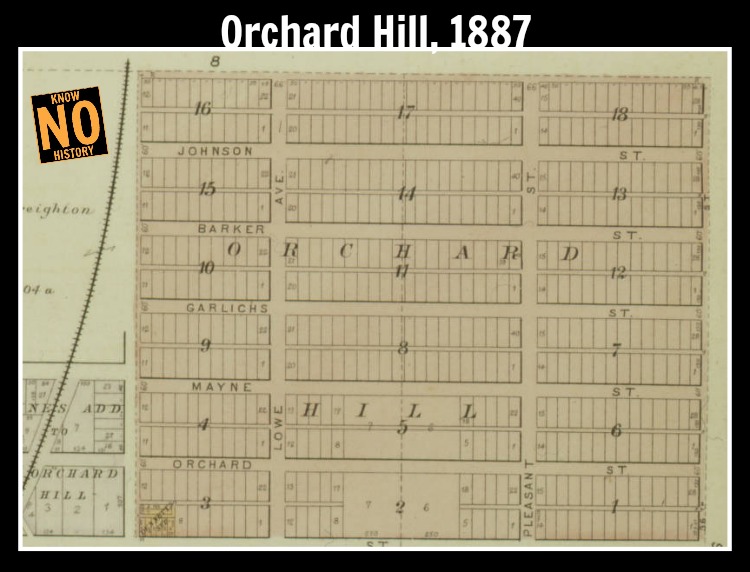
Orchard Hill was established as a residential neighborhood bounded by Hamilton Street on the south, Blondo Street on the north, North 36th Street on the east and North 40th Street on the west. It was established in 1886 after an old farmer died and his estate sold the land to developers.
Trying to Steal a Farmer’s Land

A few years before Omaha was founded, the US Army sent a surveyor west from the Missouri River to plat a road that would allow troops to move quickly to the frontier. This pathway, which was merely two wagon ruts running between hills, up easy draws and along ridge lines, was called Military Road. Part of Military Road became present-day Hamilton Street between approximately North 36th and the intersection of Hamilton and Military Street today.
Founded in 1854, the land comprising Orchard Hill was originally a homestead claimed by Alexander Baker the same year Omaha was settled. Baker selected a section of land with the Military Road on its southern boundary. The Baker Farm was staked out, a settlement cabin was built and Baker lived there with his family.
Three years after he built his house and began turning the prairie into farmland, Baker received a visit from the notorious Omaha Claim Club. This group was a vigilante crime gang made of so-called “respectable men” whose names would later grace Omaha streets, parks and other civic places.
One of the members of this club was Charles W. Pierce, who decided he wanted Baker’s land and rallied his fellow Claim Club members to his aid after Baker wouldn’t sell. In August 1857, a gang of 20 men came to Baker’s house with guns, and intimidated Baker to sign over his land to Pierce. Pierce offered Baker the ability to rent his house back though, and Baker took him up on the offer.
Baker took Pierce up on his offer, renting the house and the land. Soon after though, he took Pierce to court, as well as the New York-based financier who funded Pierce’s “investment,” William S. Morton. In the first “serious” court case to come of out Omaha, in Baker v. Morton, the Supreme Court of the Nebraska Territory found that this was a type of contractual holdup and gave Baker back his land. The Omaha Claim Club lost much of its authority after this and was dissipated in 1868.
Afterwards, Baker went back to farming. Once he busted the prairie grasses, he planted acres of corn, in addition to keeping cows, chickens, pigs and geese. He planted groves of trees on the western end of his section, which was 160 acres. Those trees included walnut trees and apple orchards. Baker graded his Orchard Road from the eastern edge of his land at present-day North 36th Street to nearly North 48th, which was the western boundary.
Baker Moves On
In the 1870s, Baker was so well-thought of in the area that he was elected to be a representative in the Nebraska Legislature. In 1884, his neighbor to the south, Sophia Lowe, was preparing to sell her land to an upstart real estate magnate named Samuel Mercer, and some land to the southeast was sold to George Bemis. His neighborhood to the east was a farmer named Frederick Brown.
Soon, Baker sold his land too.
The Baker Farm was recognized as a catch within the city’s real estate community. Streets were platted and lots were sold, and money was ready to be exchanged. Baker’s old Orchard Road was renamed Charles Street, and a block north, Mayne Street became Seward Street. Everything was primed for a solidly middle class neighborhood to be established, and that’s exactly what was coming.
Baker took his newfound wealth and moved to Grand Island, where he was a wealthy and influential city leader. Mercer built the Walnut Park neighborhood; Brown and Lowe’s land became the Prospect Place and Pleasant Hill neighborhoods, and Bemis Park was carved from Moses Shinn’s land.
From Farm to Neighborhood
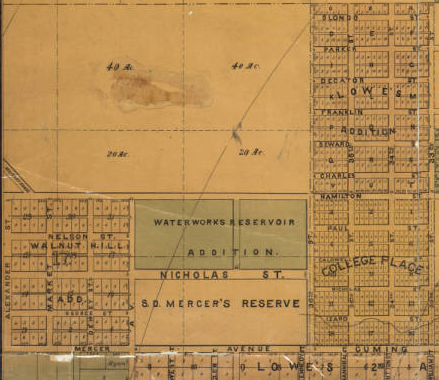
Everything changed in 1886. That year, the Baker Farm went up for sale in the late fall. It was quickly snatched up and development started by the end of the year. Farmer Baker’s orchards and fields were mostly bulldozed, and the land was quickly prepared for houses. Streets, sidewalks and gas-powered street lamps were installed, and other preparations were made. Early houses were large for their time, with two- and three-stories fill with at least six or seven rooms, and filled with high quality, high cost materials. The initial vision for the neighborhood was to be an upper middle class family area, filled with professionals who commuted downtown on Samuel Mercer’s horse-drawn railroad that ran on Cuming Street.
The Orchard Hill Improvement Club was a mighty force in the first three decades of the neighborhood. Meeting at Knight Hall on the southwest corner of North 40th and Hamilton Streets, the club was responsible for countless improvements, vast amounts of advocacy and a variety of other activities throughout the neighborhood. In 1904, there were 14 committees active in the club. They included committees on sidewalks, lamp posts, trees, streets and more. The group tried to fend off small housing developments in the neighborhood, advocated for the boulevard to be built there and regularly took action on behalf of their properties and neighborhood. News of the club ended in 1914.
Some of the early important buildings in the area around Orchard Park were celebrated by a Sunday World-Herald article congratulating the neighborhood and the improvement club in 1904. They included the Swedish Zion Lutheran Church, founded in 1902 in the neighborhood; St. Cecilia Catholic Church, founded in 1888, founded nearby; the Mercer Mansion, built in 1885 at 3902 Cuming Street on Walnut Hill; the Coryell House; Walnut Hill Methodist Church, founded in 1893.
Within a decade of its founding, the neighborhood may have been 20-30% filled. Unlike nearby neighborhoods to the east and south, the Orchard Hill neighborhood and others to the north took their time. Between 1886 and 1929, there were more than a hundred houses built in the 24-plus blocks of the neighborhood. Today, Orchard Hill is best described as having blocks filled partly with historic middle class homes of one, two and three stories from the late 19th century, and modern homes not built until the 1960s.
There were reasons for Orchard Hill developed unevenly in its first 130 years of its existence. They include poor transportation planning, indifferent city regulations on housing, and the lack of various amenities. This article explores some of those issues. It also explores the houses, businesses and other institutions in context of the neighborhood’s development.
The Homes of Orchard Hill
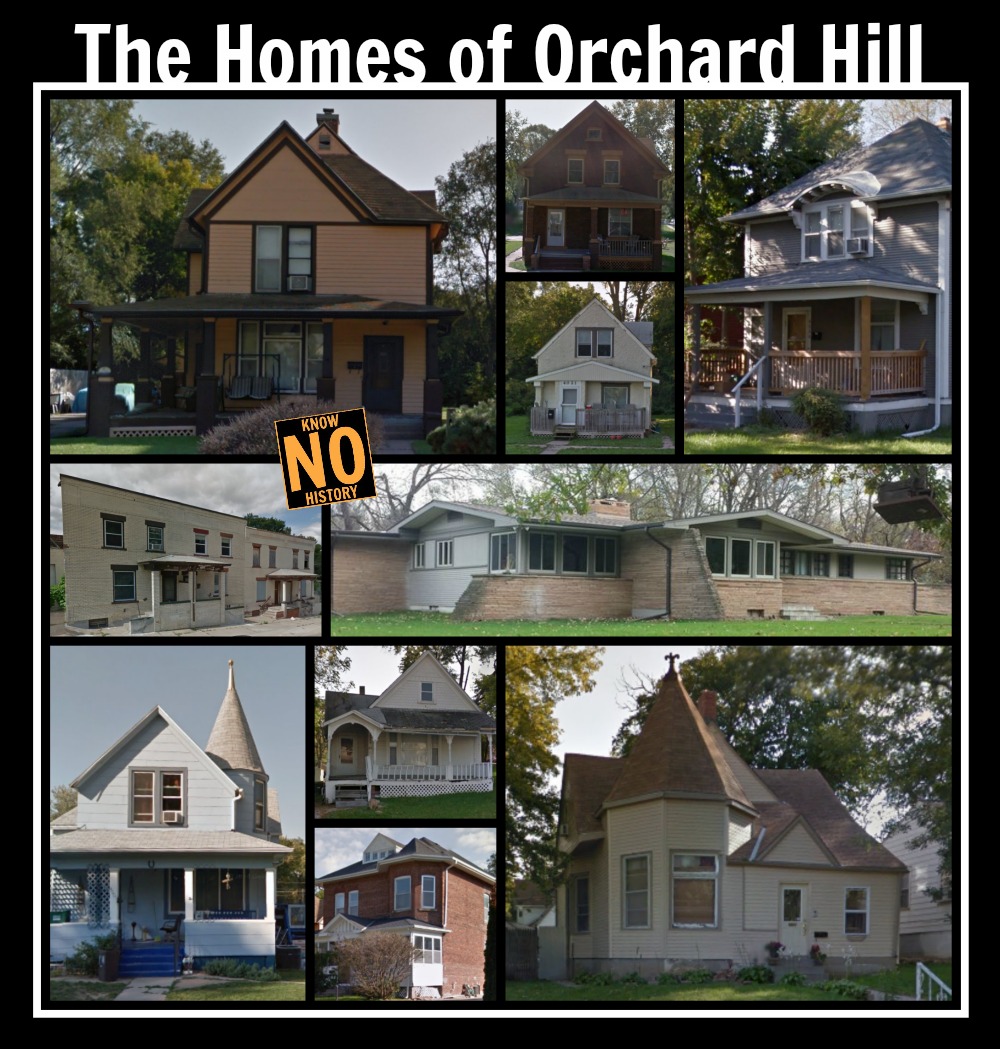
There are dozens of notable historical homes in the Orchard Hill neighborhood. Packed with ranch style homes from the last 60 years and bungalows from the previous 75, there are several substantial larger homes throughout Orchard Hill, too. While many of these are typical American foursquare style homes, there are Queen Anne houses throughout, too. The homes in this neighborhood are notable for their distinctive architecture, period-relevant development patterns, their former residents and their sheer age, which in several cases goes back more than 125 years.

For instance, 3853 Parker Street was built in 1895. Its a two-story, seven room house that sits on an average size lot from that era. Today, its a stripped down box that’s barely distinguishable from the houses nearby; in its heyday, it was surely a Queen Anne style family home with Eastlake style decorations inside and out. In 1905, a fine two story brick house was built at 3833 Parker Street as a neighbor to the previous house. Its a 2,500 square foot house with 10 rooms that’s currently divided into apartments; however, in at its peak the home was a fine testament to the neighborhood’s veracity. Although much smaller, its next door neighbor is kept in good condition, offering a glimpse into the past of these blocks. The house next to that at 3827 Parker is a fine example of mid-era construction in Orchard Hill. With only 1,300 square feet in six rooms, its not a large house. However, its stucco exterior and Craftsman style accents allude to its status as a middle class home in a central Omaha neighborhood when it was built in the 1920s. At 3819 Parker is a 1905 Eastlake style home, with scallop siding and deluxe features on the exterior. There are several new homes that have infilled this particular street that were built within the last decade.

At 1815 John A. Creighton Boulevard, there’s a spectacularly out-of-place, yet distinguished home. Its an eclectic rambler with features that resemble a Frank Lloyd Gehry design. There are sloped walls, a low roofline, hew stones on the exterior surround, and hints of period designs on the interior. There are other long, low Ranch style ramblers in their neighborhood, but none as distinctive as this one.

The home at 3737 Decatur is an eclectic Eastlake style home on a large corner lot. While there are two semi-remarkable 1895 homes further west, neither is as notable as the 1910 American Foursquare located at 3841 Decatur, which has almost 1,400 square feet. A solid two-story home with a large front porch, it sits strongly at the top of the hill.
Awkwardly, its neighbor is bizarre. Standing at 3853 Decatur, there is a 13,000 square foot building that is apparently a senior housing unit that’s privately owned. Built in 1959, its in poor condition today. Its necessary though, with more than 40 units for its tenants. How did this building get built? Who thought this was a good idea? And why is it in poor condition now?
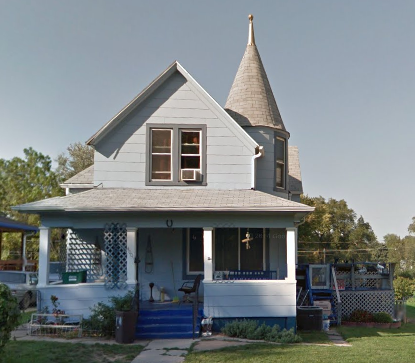
Built before the neighborhood was established, 4021 Decatur was built in 1880. Although its pretty rough on the exterior and small, less than 1,000 square feet, the house is a hallmark of the neighborhood that should be respected. 3868 Franklin is an eclectic 1890 home with Gothic style rooflines. Two large American Foursquare style houses built in 1910 sit at 3858 and 3852 Franklin, as well as an 1895 Queen Anne style home at 3840 Franklin. There are a lot of infill homes along Franklin Street from the Belt Line Railway eastward to North 36th Street.
In 1906, a fine foursquare house was built at 3613 Franklin Street. Clad in dark brown brick, it has brighter accentuating trim and other notable details. Its neighbor at 3609 Franklin was clearly playing catchup when it was built. A fine cottage style home in dark brick, too, it was built in 1926 and is nearly as elegant as the home next door. These homes lead to Franklin Elementary School, which isn’t technically in the Orchard Hill neighborhood, but is definitely still a large part of the community.

There were several grandiose homes built the top of the hill on Seward Street. There are almost a dozen American Foursquare homes there, along with a few more notable homes. In 1895, a Queen Anne style home with Stick features was constructed at 3839 Seward. It has several notable historic features. The home at 3830 Seward has survived an interesting fate. Originally constructed in 1900, it was bought by Habitat for Humanity and renovated in the 1990s, instead of their seemingly routine practice of bulldozing old homes in North Omaha. This house is significant because of its beautiful turret and hints of past features. The 1890 Queen Anne at 4006 Seward has a wonderful turret and looks like its in good condition. At 4004 Charles Street, there’s another 1890 house, but with nothing except that every house on this block – six of them – were built between 1890 and 1895. The house at 4004 Charles is a standard American Foursquare, except with an eclectic feature on the second floor. A dozen strong American Foursqare houses sit at the top of Charles Street, leading eastward. The house at 3835 Charles was stellar Queen Anne style house until it was poorly renovated. Down the street, the house at 3643 Charles was built in 1888, and has almost 1,300 square feet. The houses at 3602 and 3608 Charles have much older features than the Douglas County Assessors office construction dates of 1900, and I’d suspect they’re both older than that.

The present-day house at North 36th and Charles Streets was originally built in 1902 as the first Zion Lutheran Church. For a decade, all of the services were held in German. The church built a new huge new building at N. 36th and Lafayette in 1919. However, in 1936 it was forced to merge with Trinity Lutheran church because of the Great Depression.
Along Hamilton Street, between North 36th and the Belt Line Railway, there are several older homes. The house at 3840 Hamilton was built in 1890, while the one at 3828 Hamilton was built in 1888. Built across the street from the Walnut Hill Reservoir and Pumping Station, the home at 3848 Hamilton is more than 2,100 square feet and was built in 1890. This home, along with its former neighbors at 3846 Hamilton and 3850 Hamilton were all designed by prolific Omaha architect John Latenser.
On an interesting note, there are no properties within the boundaries of the Orchard Hill neighborhood that are recognized by the City of Omaha Landmark Heritage Preservation Commission as Omaha Landmarks, nor are they listed on the National Register of Historic Places. This is surely an oversight that will be corrected in the foreseeable future; in the meantime, I’ll just write this article and share it widely in hopes that someone will notice.
Businesses

The Orchard Hill neighborhood doesn’t have a lot of amenities. Despite being located on the Belt Line Railway, there were few light industry businesses the neighborhood. One small corner of the neighborhood has a row of commercial storefronts, while there are no other storefronts throughout the area.
There is also only one historic church currently standing in Orchard Hill. The Saint Andrew Episcopal Church and rectory were both built on the northeast corner of North 41st and Charles Street in 1891. Originally founded as a mission for the Walnut Hill area, St. Andrew’s became the only Episcopalian in the larger area including Walnut Hill, Cathedral, Prospect Hill, and beyond. The building was dedicated by Bishop Worthington himself. Today, the building is home to Kingdom Builders Christian Church.
As a note, the Olympia Cycles building at North 40th and Hamilton isn’t technically in the Orchard Hill neighborhood, although a lot of people associate it that way. This building was originally called the Knight Hall (not Catholic).
John A. Creighton Boulevard

Orchard Hill is home to one part of Omaha’s boulevard system, and was almost tied together with the larger network that efficiently moved cars around Omaha starting in the 1890s.
The first boulevards in Omaha were designed by H.W.W. Cleveland, a nationally renowned landscape architect. When they were first envisioned, Omaha’s boulevard system was seen as an extension of the city’s parks. They were designed to feature swirling drives and limited interruptions like streetcars or intersections. Instead, they were to be lined with stately trees and grand flower beds, calming and sedate while feeling special and unique.
As housing developments throughout North Omaha became acquainted with this romantic notion, they wanted their own. The mightily active citizens of Orchard Hill wanted one too, and got it in the early 1890s. In 1909, this section was renamed in honor of Omaha’s Count John A. Creighton. The John A. Creighton Boulevard runs through the eastern part of Orchard Hill, south-north from the Adams Park neighborhood to the north to Hamilton Street, where it ends.
However, while the boulevard seemed like a great idea, it wasn’t met with success. Less than 20 years after it was laid out, in 1917 a City of Omaha report said, “As it is now, [John A.] Creighton Boulevard, with its many possibilities, is very little used, to the detriment of the properties along it. Consequently, it is an expense to the city without bringing adequate returns.”

Alas, the boulevard continues today. In an unfortunately bland way, in most parts it carries traffic from Bedford Place at North 33rd and Paxton Boulevard southwards through Adams Park, then due south through the Orchard Hill neighborhood. The City of Omaha reports that it is remarkable for having 150-foot right-of-ways throughout the Orchard Hill neighborhood, as the rest of the boulevard going north has 100-feet or less. The boulevard just stops at Hamilton Street. Looking at maps, its clear the route was supposed to connect to Glenwood Avenue and Lincoln Boulevard, which would’ve connected it to the rest of the city’s boulevard system. It didn’t though.
In 2013, John A. Creighton Boulevard was listed on the National Register of Historic Places as part of the Omaha Parks and Boulevard System. There is a plan to mark Hamilton Street from John A. Creighton Boulevard west to Mercer Boulevard in order to make their connection more obvious.
White Flight
As with most North Omaha neighborhoods east of North 42nd Street, white flight affected the Orchard Hill neighborhood. There’s evidence that in white people began moving out of the neighborhood in the 1930s and continued through the 1970s. However, Orchard Hill proves that white flight isn’t synonymous with neighborhood neglect.
While I was surveying this neighborhood, I noticed some very excellent current developments for an older neighborhood in North Omaha. It looks as if this neighborhood is in-filling currently, and older homes are receiving upgrades rather than being torn down! Both of these are phenomenal in the larger North Omaha community.
Given its proximity to Walnut Hill, Bemis Park and other fine districts in the area, this makes sense for Orchard Hill; however, in North Omaha this still seems exceptional. In my scans of other historic neighborhoods in North Omaha, I’ve seen infilling and updating mostly end in the 1950s when white flight was at its most pronounced. Orchard Hill seems to have escaped this fate, with homes continuing to be built and updated through the 1960s, into the 1990s and up to today.
Additionally, it looks as if the City of Omaha has refurbished parts of John A. Creighton through Orchard Hill. New sideways, new concrete and new walkups were installed on several blocks.
You Might Like…
- A History of North Omaha’s Walnut Hill Neighborhood
- A History of the Walnut Hill Reservoir in North Omaha
- A History of the Gold Coast Historic District
MY ARTICLES RELATED TO 45th and MILITARY
Military Road | Military Theater | Clifton Hill | Orchard Hill Neighborhood | Walnut Hill | Fontenelle Boulevard | Nebraska School for the Deaf | Saddle Creek Road | Cuming Street
MY ARTICLES ABOUT HISTORIC NEIGHBORHOODS IN NORTH OMAHA
National Register of Historic Places Historic Districts in North Omaha: 24th and Lake Historic District | Benson Downtown Historic District | Country Club Historic District | Dundee/Happy Hollow Historic District | Fairacres Historic District | Fort Omaha Historic District | Minne Lusa Historic District | Nicholas Street Historic District
Historic Neighborhoods in North Omaha: Bedford Place | Belvedere Point | Bemis Park | Benson | Briggs | Bungalow City | Carter Lake, Iowa | Central Park | Clifton Hill | Collier Place | Creighton University | Crown Point | DeBolt | Druid Hill | East Omaha | Fairfax | Florence | Florence Field | Fort Omaha | Fontenelle View | Gifford Park | Gold Coast (Cathedral) | High Point | Jefferson Square | Kellom Heights | Kountze Place | Lakewood Gardens | Little Russia | Long School | Malcolm X Memorial | Miller Park | Miller Park Duplex Historic District | Monmouth Park | Montclair | Near North Side | North Downtown Omaha | Omaha View | Orchard Hill | Plum Nelly | Prettiest Mile in Omaha | Prospect Place | Raven Oaks | Redman | Saratoga | Sherman | Squatter’s Row | Sulphur Springs | Ponca Hills | Wakonda | Walnut Hill | Winspear Triangle | Wyman Heights
Lost Towns in North Omaha: Benson | Briggs | DeBolt | East Omaha | Florence | Saratoga | Sulphur Springs
MY ARTICLES ABOUT THE BELT LINE RAILWAY IN NORTH OMAHA
Businesses:4402 Florence Blvd | 4426 Florence Blvd | 4225 Florence Blvd | Omaha Casket Company | U.S. Brush Company | Murphy, Wasey and Company Factory | Iten-Barmettler Biscuit Company | Uncle Sam Breakfast Food Company | Storz Brewery | Douglas Motors Corporation
Neighborhoods: Nicholas Street Historic District | Squatter’s Row | Near North Side | North Omaha Bottoms | Sulphur Springs | Saratoga | Bedford Place | Plum Nelly | Clifton Hill | Orchard Hill | Walnut Hill | Military Avenue
Related: Railroads | 30th and Ames | 16th and Locust | 40th and Hamilton
Elsewhere Online
- Freeman, B. (Feb 23, 2016) “‘It’s time for the old girl to be open’: Omaha’s 40th Street Theatre is salvaged from the scrapheap,” Omaha World-Herald.


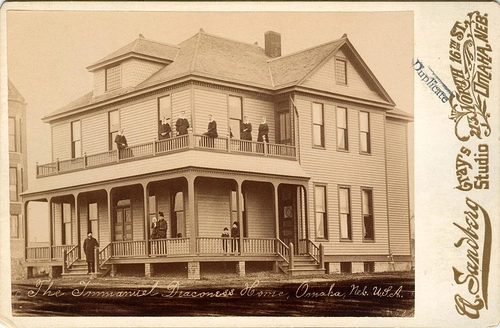

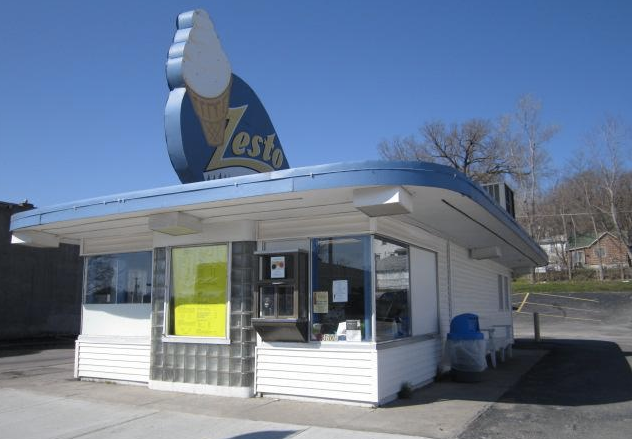
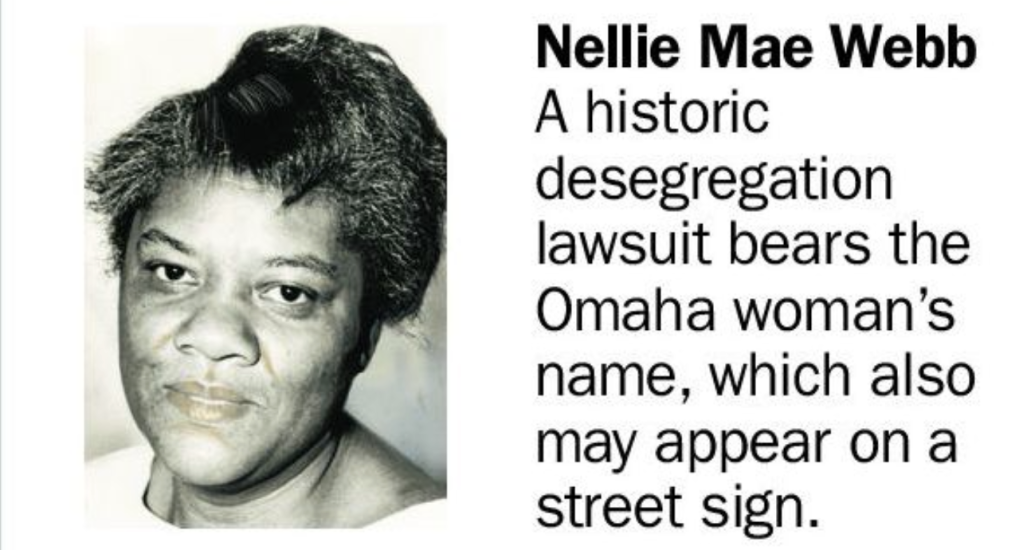
Leave a comment